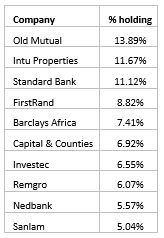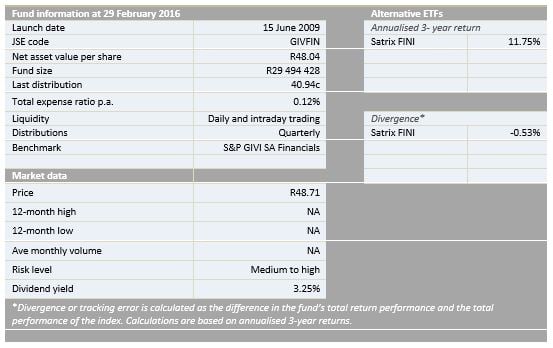Intellidex Reviews: NewFunds S&P GIVI SA Financial 15
In this note we consider one of the specialist financials ETFs, NewFunds S&P GIVI SA Financial 15 (by Absa). It is one of two ETFs listed on the JSE which provide exposure to the financial sector, the other is the Satrix FINI. They use different approaches. The NewFunds ETF is weighted by intrinsic value, and intrinsic value is derived from projected future cash flows, which the fund issuer calculates. The ETF invests in the 15 financial companies with the best projected cash flows and the lowest volatility. The Satrix fund invests in the 15 biggest financial companies according to their market capitalisation (excluding locked-in shares such as those held by promoters, founders and governments). The NewFunds ETF therefore is similar to a more actively managed fund in which a fund manager takes active decisions based on their view of prospects for companies while the Satrix fund is passive in tracking the index.
Suitability: In this and the next two notes we will look at ETFs that specialise in the three main subsectors of the JSE – financials, industrials and resources. The idea behind such subsector funds is that they allow you to fine tune your exposures depending on your views of the likely prospects for different sectors. They can also be “building blocks” to assemble a portfolio with different sectors weightings from those found in broader diversified portfolios. These funds suit more active investors who want to take a view on the prospects for different segments of the economy. For less active investors, a broader fund with wider exposures is probably more appropriate, such as our two favourites, the NewFunds Swix 40 and the Satrix Divi.
What it does: The fund replicates the price performance of the S&P GIVI SA Financials Index, an index which represents 15 stocks from the S&P GIVI SA composite, constructed using GICS financials sector classification (see below for a key to this alphabet soup). The approach favours counters with the highest intrinsic value and lowest volatility, subject to certain liquidity constraints. However, the maximum weight of each stock in the index is capped at 30%.
Here is what the acronyms stand for:
- GIVI stands for Global Intrinsic Value Index
- GICS means Global Industry Classification Standard. It is a globally accepted asset classification methodology (a way of deciding whether a stock is a “financial” or “industrial” for example) developed in 1999 by Morgan Stanley Capital International (MSCI) and Standard & Poor's (S&P).
Advantages: Because the fund uses intrinsic value as a determining factor for its investments, it means it is forward-looking, based on the expected performances of each company. We think this is a more robust way to construct a portfolio than the market-cap approach. And because it gives more weight to counters that have lower risk (low volatility), it also somewhat limits the potential loss of capital.
Disadvantages: Although it tries to limit the idiosyncratic risk of individual assets by capping them at 30% of the portfolio, we think the cap is too high and performance of the fund could potentially be skewed by one asset. However, the fund’s current weightings do not reflect this.
Top holdings: The top 10 holdings constitute 83% of the overall portfolio. The biggest stock, Old Mutual, is 13.9% of the fund. It is worth noting that the top holdings are blue chips which have performed relatively better in the past and have brighter prospects. These asset holdings vindicate the criteria used to construct the fund: intrinsic value and low volatility.

Risk: There are two important risks to think about. First, the fund is concentrated in one broad sector and all companies are very responsive to similar risk factors. It is important therefore that this ETF forms part of a portfolio’s wider equity holdings that also include other sectors such as an industrial stocks. Second, it is an all-equity investment which is more volatile than other asset classes such as bonds and cash.

Fees: The total expense ratio is 0.12%. This excludes brokerage and transactional costs.
Historical performance: The fund’s performance depends on the method used to invest. A lump-sum investment closely mimics the index performance. However, investing through regular instalments usually lags the performance of the index, according to historical evidence, and the pattern is apparent in other ETFs too. This supports the need to invest for longer periods when it comes to equities. The performance described in the table below is for a lump-sum investment.
The fund has generated an annualised return of 12.8% over the past three years compared with 11.8% for the Satrix FINI.

Fundamental view: The fund stands to benefit in the short term from SA’s rising interest rates which help the profitability of banks. However, prospects may be hurt in the medium term as consumers tend to borrow less in the higher interest rate environment and experience greater stress servicing existing debt. Also, financial companies tend to generate a large portion of their earnings in SA, and the local economy is in some distress with various institutions have revised their growth forecasts for this year down to 1%. However, investors can take some comfort from the knowledge that SA’s financial sector is regarded is one of the most sound globally.
Alternatives: Its closest peer is the Satrix FINI ETF which is weighted according to the market capitalisations of each company excluding locked-in shares such as those held by promoters, founders and governments.
BACKGROUND: Exchange traded funds (ETFs)
Exchange Traded Funds (ETFs) are passively managed investment funds that track the performance of a basket of pre-determined assets (in this case, financial companies). They are traded the same way as shares and the main difference is that whereas one share gives exposure to one company, an ETF gives exposure to more than one company in a single transaction. ETFs can be traded through your broker the same way as shares, say, on the Easy Equities platform. In addition, it qualifies for the tax-free savings account, where both capital and income gains accumulate tax free.
Benefits of ETFs
- Gain instant exposure to various underlying shares in one transaction
- They diversify risk because a single ETF holds various shares
- They are cost-effective
- They are liquid – it is usually easy to find a buyer or seller and they trade just like shares
- High transparency through daily published index constituents
Disclaimer
This research report was issued by Intellidex (Pty) Ltd. Intellidex aims to deliver impartial and objective assessments of securities, companies or other subjects. This document is issued for information purposes only and is not an offer to purchase or sell investments or related financial instruments. Individuals should undertake their own analysis and/or seek professional advice based on their specific needs before purchasing or selling investments. The information contained in this report is based on sources that Intellidex believes to be reliable, but Intellidex makes no representations or warranties regarding the completeness, accuracy or reliability of any information, facts, estimates, forecasts or opinions contained in this document. The information, opinions, estimates, assumptions, target prices and forecasts could change at any time without prior notice. Intellidex is under no obligation to inform any recipient of this document of any such changes. Intellidex, its directors, officers, staff, agents or associates shall have no liability for any loss or damage of any nature arising from the use of this document.
Remuneration
The opinions or recommendations contained in this report represent the true views of the analyst(s) responsible for preparing the report. The analyst’s remuneration is not affected by the opinions or recommendations contained in this report, although his/her remuneration may be affected by the overall quality of their research, feedback from clients and the financial performance of Intellidex (Pty) Ltd.
Intellidex staff may hold positions in financial instruments or derivatives thereof which are discussed in this document. Trades by staff are subject to Intellidex’s code of conduct which can be obtained by emailing mail@intellidex.coza.
Intellidex may also have, or be seeking to have, a consulting or other professional relationship with the companies mentioned in this report.
Subscribe To Our Research Portal
Search all research
Let Us Help You, Help Yourself
From how-to’s to whos-whos you’ll find a bunch of interesting and helpful stuff in our collection of videos. Our knowledge base is jam packed with answers to all the questions you can think of.